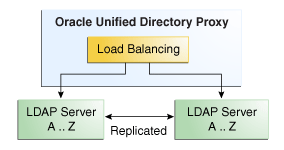| Skip Navigation Links | |
| Exit Print View | |

|
Oracle Fusion Middleware Deployment Planning Guide for Oracle Unified Directory 11g Release 1 (11.1.1) |
| Skip Navigation Links | |
| Exit Print View | |

|
Oracle Fusion Middleware Deployment Planning Guide for Oracle Unified Directory 11g Release 1 (11.1.1) |
1. Overview of Oracle Unified Directory
2. Overview of the Directory Server
3. Overview of the Proxy Server
4. Overview of the Replication Gateway
5. Building Blocks of the Proxy Server
6. Example Deployments Using the Directory Server
7. Example Deployments Using the Proxy Server
Deciding Your Proxy Deployment Type
Configuration 2: Simple Distribution
Configuration 3: Failover Between Data Centers
Configuration 4: Distribution with Load Balancing
Configuration 5: Distribution with Failover Between Data Centers
8. Simple Proxy Deployments Using the Command Line Interface
When deploying the Oracle Unified Directory proxy using load balancing, all requests received through the Oracle Unified Directory proxy are routed to one of the remote LDAP servers. As illustrated in Figure 7-1, the remote LDAP servers are replicated and contain the same data. The number of supported remote LDAP servers is not limited.
Figure 7-1 Simple Load Balancing

The requests are routed to one of the remote LDAP servers based on the load balancing algorithm set during deployment.
The load balancing algorithms are:
failover
generic
optimal
proportional
saturation
searchfilter
For more information on the different load balancing algorithms, see Load Balancing Using the Proxy.
The algorithm can be bypassed by a client connection affinity. If you set client connection affinity, the Oracle Unified Directory proxy will use the load balancing algorithm for the first request, but for the following request will disregard the load balancing algorithm set and will try to reuse the same route for a new operation on the same client connection, for example, depending on the type of client affinity set. For more information, see Setting Client Connection Affinity in Oracle Fusion Middleware Administration Guide for Oracle Unified Directory.
The advantages of using load balancing deployment are the high availability of the data, as well as an adapted workload on the remote LDAP servers. For example, if one of the remote LDAP servers in your configuration becomes unavailable, the load balancing will route the request to another remote LDAP server. In this case, the failure is not visible to the client and there is no service disruption.
A simple load balancing deployment can be configured easily during the Oracle Unified Directory proxy installation, using the oud-proxy-setup tool.